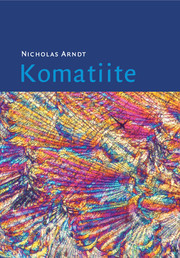Book contents
- Frontmatter
- Contents
- Preface
- Part I Background information – description of the field characteristics, mineralogy and geochemistry of komatiites
- 1 A brief history of komatiite studies and a discussion of komatiite nomenclature
- 2 Brief descriptions of six classic komatiite occurrences
- 3 Field characteristics, textures and structures
- 4 Mineralogy
- 5 Geochemistry
- 6 Isotopic compositions of komatiites
- 7 Experimental petrology
- Part II Interpretation – the manner of emplacement, the origin and the tectonic setting of komatiites
- References
- General index
- Localities
- Plate section
2 - Brief descriptions of six classic komatiite occurrences
from Part I - Background information – description of the field characteristics, mineralogy and geochemistry of komatiites
Published online by Cambridge University Press: 27 August 2009
- Frontmatter
- Contents
- Preface
- Part I Background information – description of the field characteristics, mineralogy and geochemistry of komatiites
- 1 A brief history of komatiite studies and a discussion of komatiite nomenclature
- 2 Brief descriptions of six classic komatiite occurrences
- 3 Field characteristics, textures and structures
- 4 Mineralogy
- 5 Geochemistry
- 6 Isotopic compositions of komatiites
- 7 Experimental petrology
- Part II Interpretation – the manner of emplacement, the origin and the tectonic setting of komatiites
- References
- General index
- Localities
- Plate section
Summary
Introduction
In this section I briefly describe six regions that illustrate the main characteristics of komatiites: (1) ∼3.5 Ga komatiites from the Barberton greenstone belt in South Africa; (2) 2.7 Ga komatiites from the Abitibi Belt in Canada; (3) ore-bearing 2.7 Ga komatiites from Kambalda in Western Australia; (4) 1.9 Ga komatiitic basalts from the Gilmour Island in Canada; (5) Fe–Ti-rich komatiites from Karasjok, Scandinavia, and (6) Cretaceous (90 Ma) komatiites from Gorgona Island, Colombia. A summary of the main characteristics of komatiites in each of these areas is given in Table 2.2 (page 23). A case could have been made to include various other komatiite localities. The komatiites from Kambalda, for example, were included only after persuasive lobbying from my coauthors, who contributed this section to illustrate the characteristics of a type of thick, highly magnesian komatiitic unit that is abundant throughout the eastern part of the Yilgarn Craton and in many other greenstone belts. In addition, these komatiites contain the type examples of komatiite-hosted Ni-sulfide deposits. Euan Nisbet strongly advocated the inclusion of the 2.7 Ga komatiites from the Belingwe belt in Zimbabwe, which are renowned for their unusually good state of preservation and have been the subject of several excellent studies by his group. However, these rocks are similar in most important respects to the komatiites from the Abitibi belt. Their well-preserved textures and primary mineralogy and their chemical compositions are described in detail in Chapters 3–6.
- Type
- Chapter
- Information
- Komatiite , pp. 16 - 52Publisher: Cambridge University PressPrint publication year: 2008
- 1
- Cited by



